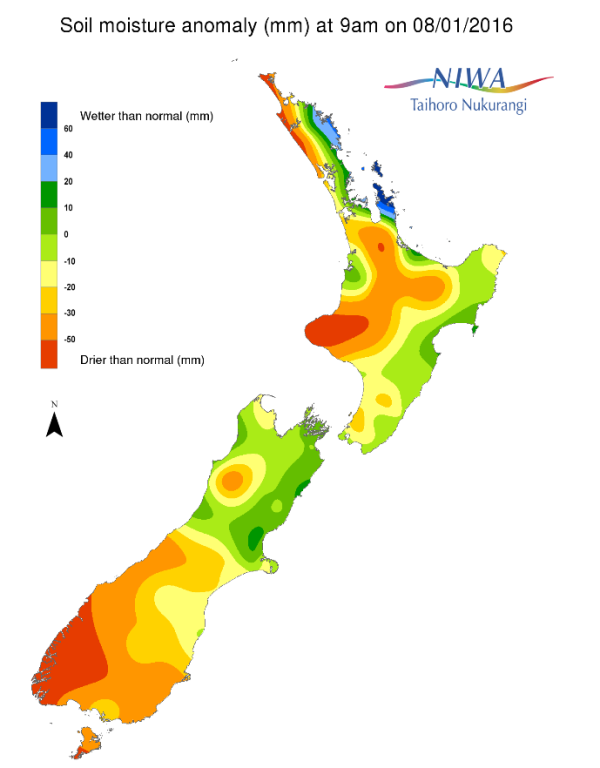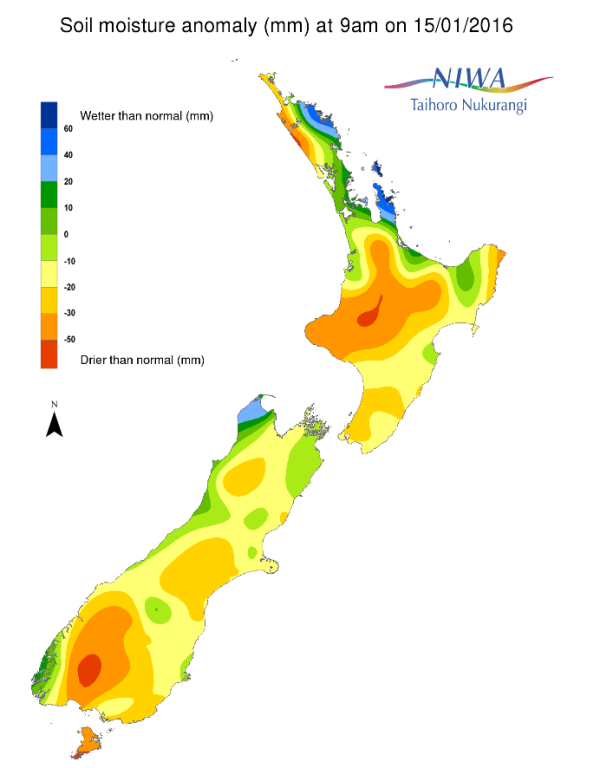A weekly update describing soil moisture across the country to help assess whether severely to extremely dry conditions are occurring or imminent. Regions experiencing these soil moisture deficits are deemed “hotspots”. Persistent hotspot regions have the potential to develop into drought.
Soil Moisture
Over the past week, soil moisture levels across the North Island have generally remained the same or decreased. The exception is the Taranaki region where soil moisture levels increases slightly. Presently, central Waikato, parts of south coastal Taranaki, northern Manawatu-Whanganui, far eastern Gisborne and parts of the Wellington region have below normal soil moisture for this time of year. From the Coromandel Peninsula north through to eastern Northland soil moisture is near normal or above normal.
For the South Island, soil moisture levels have generally remained unchanged or increased except for areas north of Banks Peninsula where soil moisture levels have chiefly decreased over the past week. Presently, from eastern mid-Canterbury southwest through to much of Otago have below normal soil moisture for this time of year. The reminder of the island is experiencing near normal or below normal soil moisture for this time of year, except for the northwestern Tasman region where above normal soil moisture exists for this time of year.
Outlook
Rainfall
For the North Island, very little in the way of widespread and organised rainfall is anticipated through to next Friday. Only isolated to scattered showers are forecast with rainfall amounts over the next seven days likely less than 10 mm for much of the island. However, isolated areas about the higher terrain of the lower part of the island may receive in excess of 20m in response to a moist flow around a low over the Tasman. The driest weather is expected from Gisborne south through to Hawke’s bay where weekly rainfall may not reach 5 mm. Consequently, soil moisture levels will likely decrease for much of the island, except for pockets of the lower North Island where any locally heavier rainfall occurs.
For the South Island, rain is forecast today and tomorrow (Saturday) for much of the island. Rainfall by Saturday evening is expected to be in the order of 10-25 mm from about mid-Canterbury points south, with some of the driest areas of the Otago region possibly receiving locally greater amounts. Rainfall north of mid-Canterbury will likely be near or less than 10 mm for this event. Thereafter, the rainfall forecast next week will be largely dependent on the interaction of low pressure that is forecast to move into the Tasman and a separate low currently situated north of the country. Exact details around the movement and placement of these two systems will have a significant impact on rainfall location and amounts.
Soil moisture
However, suffice to say, that at least some rain is expected in the early-to-mid portions of next week for the northern and western parts of the island, with the potential for locally heavy rain. As a result, soil moisture levels over the next week will generally remain steady or increase from about mid-Canterbury points south as well as parts of the West Coast, Tasman and Nelson regions. For the remainder of the island soil moisture levels are likely to remain the same or decrease.
For the North Island, hotspot areas are present in extreme western Northland, central and southern Waikato, extreme eastern Gisborne, parts of the Wellington region, south coastal Taranaki as well as west coastal Manawatu-Whanganui regions. Eastern areas of the island south of Gisborne will need to be watched for hotspot development over the coming days. Additionally, aforementioned hotspot regions will need to be monitored for expansion.
For the South Island, a hotspot exists between Ashburton and just north of Oamaru in eastern Canterbury. At present time, a more significant hotspot region is present in Otago and Southland. It’s likely that by this time next week, hotspot regions will become less sizeable, or possibly eliminated entirely. Additional hotspot development is not anticipated this week.
NB: due to the timing and reporting of daily 24 hour rainfall amounts (9 am each day) and time required to compute soil moisture deficit values, the rain that occurred on Friday 15 January through to Saturday 16 of January will not be fully reflected in the soil moisture anomaly maps until Sunday 17 January.
Background
Soil moisture deficit
Soil moisture deficit is the amount of water needed to bring the soil moisture content back to field capacity, which is the maximum amount of water the soil can hold.
Soil moisture anomaly
Soil moisture anomaly the difference between the historical normal soil moisture deficit (or surplus) for a given time of year and actual soil moisture deficits.
Definitions
“Extremely” and “severely” dry soils are based on a combination of the current soil moisture status and the difference from normal soil moisture (see soil moisture maps at https://www.niwa.co.nz/climate/nz-drought-monitor/droughtindicatormaps)
Soil moisture anomaly maps
Pictured below are soil Moisture Anomaly Maps, relative to this time of year. The maps show soil moisture anomaly for the past two weeks.


